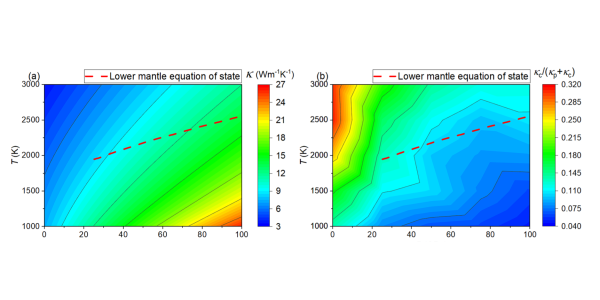A computational peek inside the lower Earth mantle
By Nicola Nosengo/NCCR MARVEL
The Earth’s lower mantle is only about 700 kilometers away - a distance that we can cover with a 1-hour flight when travelling on the planet’s surface. And yet, it is almost impossible to explore. We can’t probe its chemical composition directly, and reproducing its extreme pressure and temperature in experiments is more than challenging.
Computational methods can offer a window into this hidden world that represents represents approximately 56% of Earth's total volume and extends from 660 to 2890 km below our feet. In a new study published in Physical Review B, a group of MARVEL scientists have applied a mix of quantum simulation methods to simulate how the calcium-silicate perovskite (CaSiO3), one of the main components of the lower mantle, behaves in different pressure and temperature conditions, up to the extreme values that we expect to find at that depths. The results could improve our understanding of the Earth’s internal dynamics and evolution, as well as the models that describe how seismic waves travel during earthquakes.
Geologists believe that CaSiO3 represents about 10% of the lower mantle’s mass. But the compound can exist in different phases, characterized by different configurations of the atoms in its crystal structure. In particular, scientists can’t be sure if the cubic or tetragonal crystal is prevalent in the lower mantle, and that makes a huge difference when it comes to how sound (and thus, seismic waves) or heat travels through the mantle.

(a) Thermal conductivity of CaSiO3 at different pressures and temperatures, (b) κc /kp+kc, where κp and κc are particle-like and wave-like contributions to the thermal conductivity. The purple dashed line represents the lower mantle’s equation of state. Adapted from Shin et al, Phys. Rev. B 112, 174113 (2025).
Yongjoong Shin, a former member of Nicola Marzari’s laboratory of Theory and Simulation of Materials (THEOS) at EPFL now at the University of Santa Barbara, explains that previous computational studies of materials in the lower mantle have used molecular dynamics, a method that simulates the movement of individual particles in a chemical system by looking at how they affect each other under the effect of external forces. “But the people who tried it found out it’s not easy, because you need to deal with anharmonicity in the material”, he says. At the high temperatures found in the lower mantle, ions in the material oscillate and fluctuate in ways that are very far from idealized, harmonic oscillations (think of a pendulum that always oscillate with the same frequency). And this poses significant challenges for molecular dynamics.
The team thought to apply a more recent method called stochastic self-consistent harmonic approximation (SSCHA), first described theoretically in 2014 and made available to the community as a computer code in 2021 by a team that involved Lorenzo Monacelli, another former member of the THEOS laboratory now at the Sapienza University of Rome and co-author of this study.
After using standard density functional theory (DFT) to calculate the electronic structure of calcium silicate at zero temperature, the scientists applied SSCHA to simulate its phase diagram - that shows how the distribution of its crystal shapes changes with temperature and pressure -, its sound velocities and thermal conductivity ranging from 20 to 100 Giga pascals and from 300 to 3000 degrees Kelvin.
When it comes to the phase diagram, they concluded that the cubit and tetragonal phase can coexist between 400 K and 800 K, but that a sudden transition towards the cubic phase happens at 800 K. This means that CaSiO3 in the lower mantle must be mostly in the cubic form.
Sound velocity is the one aspect for which some experimental data were previously available. “We obtained very similar results to experiments and to previous computational studies, and our results are actually closer to experimental ones than those from molecular dynamics” says Shin.
For thermal transport, on the contrary, there was no data at all to compare with. “This is a key property, because you really want to understand how the boundary between the core and the mantle propagates heat” says Enrico Di Lucente, a co-author of the study who recently completed his PhD in the THEOS lab.
Heat can propagate in two ways through a compound: either as a flow of particles, or as a wave. “Our model allows to probe the entire phase diagram and tells you that at high pressure the wave-like propagation of heat is suppressed, but if you lower pressures and reach very high temperatures the wave-like tunnelling becomes dominant” says Di Lucente. “Considering that we can’t fully know for sure the pressure and temperature of the mantle, it’s useful to keep in mind that in some parts of the phase diagram thermal transport is non-trivial”.
These results could help design more accurate experiments about the materials in the Earth’s interior and could help seismic modelling. For computational materials scientists, the study is also important because it shows the potential of SSCHA beyond its native domain. “We hope to convince people that the very tools of materials science are useful also for other fields and that quantum simulations can be used in geophysics” says Di Lucente. “Computational methods are not yet applied to their full scale and power to study environments like the mantle but can be crucial. They have basically no cost, and we see that they work”.
Reference
Yongjoong Shin, Enrico Di Lucente, Nicola Marzari, and Lorenzo Monacelli, The thermodynamics of CaSiO3 perovskite in Earth's lower mantle, Phys. Rev. B 112, 174113 (2025). DOI: https://doi.org/10.1103/3vgz-fnth
Low-volume newsletters, targeted to the scientific and industrial communities.
Subscribe to our newsletter